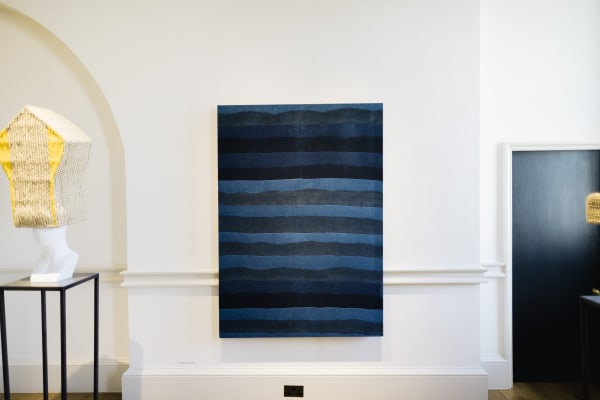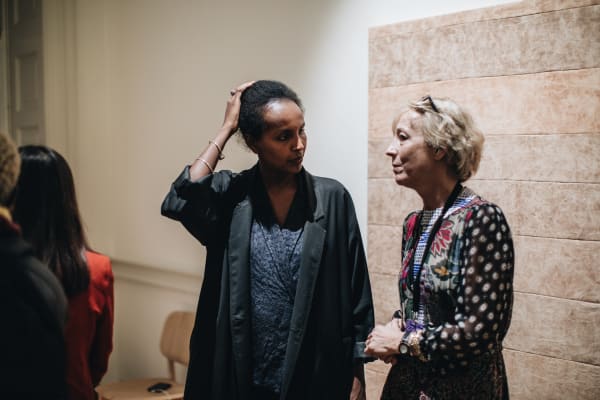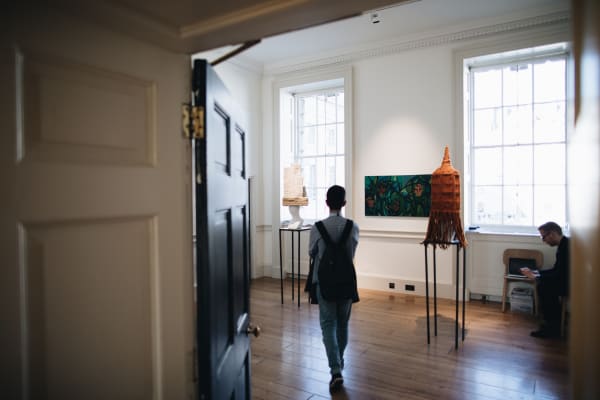Pippy Houldsworth Gallery’s first presentation at 1:54 Contemporary African Art Fair brings together works by Ayan Farah, Meschac Gaba and Faith Ringgold, looking at the ways in which contemporary African artists explore different notions of place. The gallery’s presentation at the fair is particularly timely as both Gaba and Ringgold’s works are currently on view at Tate Modern. A new collection display has just opened which features Gaba’s iconic Museum of Contemporary African Art and an early painting from 1967 by Ringgold is included in the acclaimed group exhibition Soul of a Nation: Art in the Age of Black Power. The painted, narrative quilts for which Ringgold is well known grew out of such early paintings, providing an interesting connection to the textile-based works of both Farah and Gaba.
Made specially for the fair, the two paintings on show by Ayan Farah incorporate materials sourced from Africa. The first features terracotta clay collected by the artist from the Western Sahara; drawing upon historic modes of fabric production such as Bogolanfini mud-cloth making, the resultant effect is similar to the shimmer of dappled sunlight falling across water. The second comprises swatches of indigo-dyed hemp that have been sun-bleached before being dipped in clay sourced from Nigeria. Both demonstrate how the artist records the physical and ephemeral traces of distant geographical locations by treating pieces of fabric with natural pigments and organic materials sourced from around the world.
Farah was born in Sharjah, United Arab Emirates in 1978 to Somali parents and grew up in Stockholm, Sweden. The artist received an MA in Painting from the Royal College of Art, London in 2012. Her work can be found in the permanent collections of the David Roberts Art Foundation, London and Saatchi Gallery, London.
Since the mid-1990s, Beninese-artist Meschac Gaba has investigated differences between Africa and the Western world in the construction of cultural identity. Gaba is well known for his architectonic wigs that reconstruct famous landmarks out of woven hair based on traditional African braiding styles, looking at the way in which architectural forms are imbued with cultural meaning. Over the past decade, Gaba has realised this project in cities including New York, London, Paris, Milan, and Cape Town, and the sculptures on view at 1:54 are inspired by the skyline of Amsterdam, where the artist had a solo show at the Stedelijk Museum in 2000.
Addressing the politics of museum display, Gaba is best known for his Museum of Contemporary African Art, a project in which he installed 12 'rooms' of a nomadic museum in various institutions over a period of six years starting in 1996, culminating with the presentation of a 'Humanist Space' at Documenta 11 in 2002. The entire work now belongs to the permanent collection of Tate, London, part of which is currently on show at Tate Modern in a new collection display titled Performer and Participant in the Blavatnik Building (Level 3).
Solo exhibitions include those at Tate Modern, London (2012); Ullens Center for Contemporary Art, Beijing (2009); Studio Museum, New York (2005); Palais de Tokyo, Paris (2002); Witte de With, Rotterdam (2001) and S.M.A.K. Gent (1999). Gaba will have a solo exhibition at Pippy Houldsworth Gallery, London in 2018.
Pippy Houldsworth Gallery is exhibiting a major and little-known work from the renowned American People Series by African-American artist Faith Ringgold at 1:54. This is the first time that The American People Series: Hide Little Children (1964) will be seen in the UK. Its presentation at the fair coincides with Tate Modern's Soul of a Nation: Art in the Age of Black Power and with the Brooklyn Museum’s We Wanted a Revolution: Black Radical Women, 1965-85, both of which include important Ringgold paintings from the same decade.
Ringgold’s once influential paintings created during the 1960s (with only a few notable exceptions) disappeared from view, omitted from critical, art historical discourse for more than forty years. Last year, MoMA acquired the painting now on loan to Tate Modern and the work on show at 1:54, Hide Little Children, was also tucked away until being part of Ringgold’s solo exhibition American People, Black Light: Faith Ringgold’s Paintings of the 1960s at the Neuberger Museum of Art in 2010.
An eminent civil rights activist, Ringgold’s oeuvre is driven by an intense political agenda. Unlike the overt violence which characterises other works from her iconic American People Series, Ringgold addresses the tense race relations of 1960s America through the innocence of childhood in Hide Little Children. Depicted with vibrant, angular brushstrokes, the painting captures three children, three white and two black, concealed amongst a dense forest as if playing hide-and-seek. The children's eyes, bright amongst the foliage, stare out directly towards the viewer, symbolising the importance of ‘witnessing' in a time of ignorance and complicity. In a sense, the work is an idealised attempt to protect the children from the type of atrocities happening in the ‘real world’, as depicted in Ringgold's harrowing The American People Series #20: Die.
Ringgold’s work is included in many prominent public collections including Metropolitan Museum of Art, New York; MoMA, New York; Solomon R. Guggenheim Museum, New York; Museum of Fine Arts, Boston; Brooklyn Museum, New York; Philadelphia Museum of Art; Baltimore Museum of Art; High Museum of Art, Atlanta; Newark Museum and St. Louis Art Museum.








